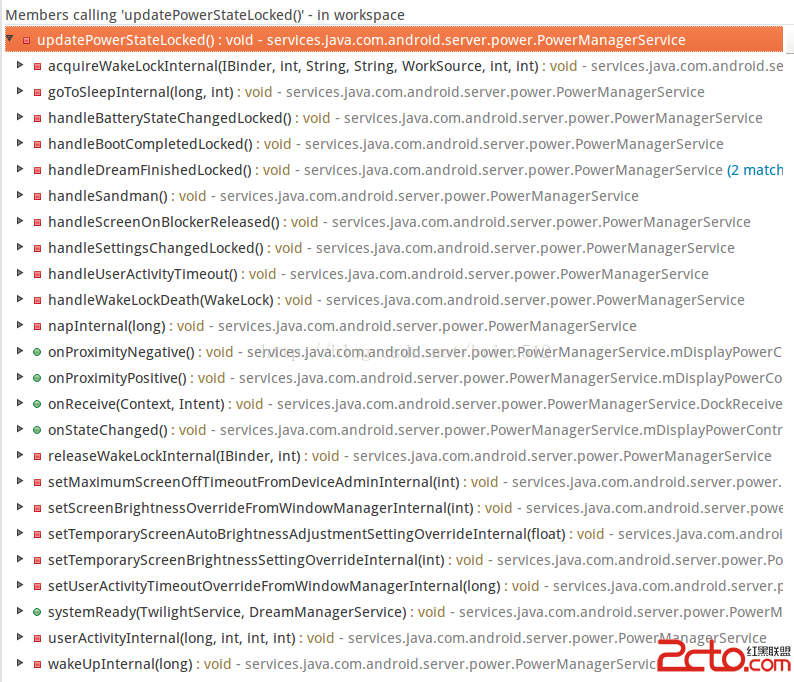編輯:關於Android編程
如何遍歷並繪制View樹?之前的文章Android中invalidate() 函數詳解(結合Android 4.0.4 最新源碼)中提到invalidate()最後會發起一個View樹遍歷的請求,並通過執行performTraersal()來響應該請求,performTraersal()正是對View樹進行遍歷和繪制的核心函數,內部的主體邏輯是判斷是否需要重新測量視圖大小(measure),是否需要重新布局(layout),是否重新需要繪制(draw)。measure過程是遍歷的前提,只有measure後才能進行布局(layout)和繪制(draw),因為在layout的過程中需要用到measure過程中計算得到的每個View的測量大小,而draw過程需要layout確定每個view的位置才能進行繪制。下面我們主要來探討一下measure的主要過程,相對與layout和draw,measure過程理解起來比較困難。
我們在編寫layout的xml文件時會碰到layout_width和layout_height兩個屬性,對於這兩個屬性我們有三種選擇:賦值成具體的數值,match_parent或者wrap_content,而measure過程就是用來處理match_parent或者wrap_content,假如layout中規定所有View的layout_width和layout_height必須賦值成具體的數值,那麼measure其實是沒有必要的,但是google在設計Android的時候考慮加入match_parent或者wrap_content肯定是有原因的,它們會使得布局更加靈活。
首先我們來看幾個關鍵的函數和參數:
1、public final void measue(int widthMeasureSpec, int heightMeasureSpec);
2、protected void onMeasure(int widthMeasureSpec, int heightMeasureSpec);
3、protected void measureChildren(int widthMeasureSpec, int heightMeasureSpec)
4、protected void measureChild(View child, int parentWidthMeasureSpec, int parentHeightMeasureSpec)
5、protected void measureChildWithMargins(View child,int parentWidthMeasureSpec, int widthUsed,
int parentHeightMeasureSpec, int heightUsed)
接著我們來看View類中measure和onMeasure函數的源碼:
[java]
public final void measure(int widthMeasureSpec, int heightMeasureSpec) {
if ((mPrivateFlags & FORCE_LAYOUT) == FORCE_LAYOUT ||
widthMeasureSpec != mOldWidthMeasureSpec ||
heightMeasureSpec != mOldHeightMeasureSpec) {
// first clears the measured dimension flag
mPrivateFlags &= ~MEASURED_DIMENSION_SET;
if (ViewDebug.TRACE_HIERARCHY) {
ViewDebug.trace(this, ViewDebug.HierarchyTraceType.ON_MEASURE);
}
// measure ourselves, this should set the measured dimension flag back
onMeasure(widthMeasureSpec, heightMeasureSpec);
// flag not set, setMeasuredDimension() was not invoked, we raise
// an exception to warn the developer
if ((mPrivateFlags & MEASURED_DIMENSION_SET) != MEASURED_DIMENSION_SET) {
throw new IllegalStateException("onMeasure() did not set the"
+ " measured dimension by calling"
+ " setMeasuredDimension()");
}
mPrivateFlags |= LAYOUT_REQUIRED;
}
mOldWidthMeasureSpec = widthMeasureSpec;
mOldHeightMeasureSpec = heightMeasureSpec;
}
由於函數原型中有final字段,那麼measure根本沒打算被子類繼承,也就是說measure的過程是固定的,而measure中調用了onMeasure函數,因此真正有變數的是onMeasure函數,onMeasure的默認實現很簡單,源碼如下:
[java]
protected void onMeasure(int widthMeasureSpec, int heightMeasureSpec) {
setMeasuredDimension(getDefaultSize(getSuggestedMinimumWidth(), widthMeasureSpec),
getDefaultSize(getSuggestedMinimumHeight(), heightMeasureSpec));
}
onMeasure默認的實現僅僅調用了setMeasuredDimension,setMeasuredDimension函數是一個很關鍵的函數,它對View的成員變量mMeasuredWidth和mMeasuredHeight變量賦值,而measure的主要目的就是對View樹中的每個View的mMeasuredWidth和mMeasuredHeight進行賦值,一旦這兩個變量被賦值,則意味著該View的測量工作結束。
[java]
protected final void setMeasuredDimension(int measuredWidth, int measuredHeight) {
mMeasuredWidth = measuredWidth;
mMeasuredHeight = measuredHeight;
mPrivateFlags |= MEASURED_DIMENSION_SET;
}
對於非ViewGroup的View而言,通過調用上面默認的measure——>onMeasure,即可完成View的測量,當然你也可以重載onMeasure,並調用setMeasuredDimension來設置任意大小的布局,但一般不這麼做,因為這種做法太“專政”,至於為何“專政”,讀完本文就會明白。
對於ViewGroup的子類而言,往往會重載onMeasure函數負責其children的measure工作,重載時不要忘記調用setMeasuredDimension來設置自身的mMeasuredWidth和mMeasuredHeight。如果我們在layout的時候不需要依賴子視圖的大小,那麼不重載onMeasure也可以,但是必須重載onLayout來安排子視圖的位置,這在下一篇博客中會介紹。
再來看下measue(int widthMeasureSpec, int heightMeasureSpec)中的兩個參數, 這兩個參數分別是父視圖提供的測量規格,當父視圖調用子視圖的measure函數對子視圖進行測量時,會傳入這兩個參數,通過這兩個參數以及子視圖本身的LayoutParams來共同決定子視圖的測量規格,在ViewGroup的measureChildWithMargins函數中體現了這個過程,稍後會介紹。
MeasureSpec參數的值為int型,分為高32位和低16為,高32位保存的是specMode,低16位表示specSize,specMode分三種:
1、MeasureSpec.UNSPECIFIED,父視圖不對子視圖施加任何限制,子視圖可以得到任意想要的大小;
2、MeasureSpec.EXACTLY,父視圖希望子視圖的大小是specSize中指定的大小;
3、MeasureSpec.AT_MOST,子視圖的大小最多是specSize中的大小。
以上施加的限制只是父視圖“希望”子視圖的大小按MeasureSpec中描述的那樣,但是子視圖的具體大小取決於多方面的。
ViewGroup中定義了measureChildren, measureChild, measureChildWithMargins來對子視圖進行測量,measureChildren內部只是循環調用measureChild,measureChild和measureChildWithMargins的區別就是是否把margin和padding也作為子視圖的大小,我們主要分析measureChildWithMargins的執行過程:
[java]
protected void measureChildWithMargins(View child,
int parentWidthMeasureSpec, int widthUsed,
int parentHeightMeasureSpec, int heightUsed) {
final MarginLayoutParams lp = (MarginLayoutParams) child.getLayoutParams();
final int childWidthMeasureSpec = getChildMeasureSpec(parentWidthMeasureSpec,
mPaddingLeft + mPaddingRight + lp.leftMargin + lp.rightMargin
+ widthUsed, lp.width);
final int childHeightMeasureSpec = getChildMeasureSpec(parentHeightMeasureSpec,
mPaddingTop + mPaddingBottom + lp.topMargin + lp.bottomMargin
+ heightUsed, lp.height);
child.measure(childWidthMeasureSpec, childHeightMeasureSpec);
}
總的來看該函數就是對父視圖提供的measureSpec參數進行了調整(結合自身的LayoutParams參數),然後再來調用child.measure()函數,具體通過函數getChildMeasureSpec來進行參數調整,過程如下:
[java]
public static int getChildMeasureSpec(int spec, int padding, int childDimension) {
int specMode = MeasureSpec.getMode(spec);
int specSize = MeasureSpec.getSize(spec);
int size = Math.max(0, specSize - padding);
int resultSize = 0;
int resultMode = 0;
switch (specMode) {
// Parent has imposed an exact size on us
case MeasureSpec.EXACTLY:
if (childDimension >= 0) {
resultSize = childDimension;
resultMode = MeasureSpec.EXACTLY;
} else if (childDimension == LayoutParams.MATCH_PARENT) {
// Child wants to be our size. So be it.
resultSize = size;
resultMode = MeasureSpec.EXACTLY;
} else if (childDimension == LayoutParams.WRAP_CONTENT) {
// Child wants to determine its own size. It can't be
// bigger than us.
resultSize = size;
resultMode = MeasureSpec.AT_MOST;
}
break;
// Parent has imposed a maximum size on us
case MeasureSpec.AT_MOST:
if (childDimension >= 0) {
// Child wants a specific size... so be it
resultSize = childDimension;
resultMode = MeasureSpec.EXACTLY;
} else if (childDimension == LayoutParams.MATCH_PARENT) {
// Child wants to be our size, but our size is not fixed.
// Constrain child to not be bigger than us.
resultSize = size;
resultMode = MeasureSpec.AT_MOST;
} else if (childDimension == LayoutParams.WRAP_CONTENT) {
// Child wants to determine its own size. It can't be
// bigger than us.
resultSize = size;
resultMode = MeasureSpec.AT_MOST;
}
break;
// Parent asked to see how big we want to be
case MeasureSpec.UNSPECIFIED:
if (childDimension >= 0) {
// Child wants a specific size... let him have it
resultSize = childDimension;
resultMode = MeasureSpec.EXACTLY;
} else if (childDimension == LayoutParams.MATCH_PARENT) {
// Child wants to be our size... find out how big it should
// be
resultSize = 0;
resultMode = MeasureSpec.UNSPECIFIED;
} else if (childDimension == LayoutParams.WRAP_CONTENT) {
// Child wants to determine its own size.... find out how
// big it should be
resultSize = 0;
resultMode = MeasureSpec.UNSPECIFIED;
}
break; www.2cto.com
}
return MeasureSpec.makeMeasureSpec(resultSize, resultMode);
}
getChildMeasureSpec的總體思路就是通過其父視圖提供的MeasureSpec參數得到specMode和specSize,並根據計算出來的specMode以及子視圖的childDimension(layout_width和layout_height中定義的)來計算自身的measureSpec,如果其本身包含子視圖,則計算出來的measureSpec將作為調用其子視圖measure函數的參數,同時也作為自身調用setMeasuredDimension的參數,如果其不包含子視圖則默認情況下最終會調用onMeasure的默認實現,並最終調用到setMeasuredDimension,而該函數的參數正是這裡計算出來的。
總結:從上面的描述看出,決定權最大的就是View的設計者,因為設計者可以通過調用setMeasuredDimension決定視圖的最終大小,例如調用setMeasuredDimension(100, 100)將視圖的mMeasuredWidth和mMeasuredHeight設置為100,100,那麼父視圖提供的大小以及程序員在xml中設置的layout_width和layout_height將完全不起作用,當然良好的設計一般會根據子視圖的measureSpec來設置mMeasuredWidth和mMeasuredHeight的大小,已尊重程序員的意圖。
 Android圖片特效:黑白特效、圓角效果、高斯模糊
Android圖片特效:黑白特效、圓角效果、高斯模糊
1.黑白效果復制代碼 代碼如下:/** * 將彩色圖轉換為黑白圖 * &n
 AndroidUI組件SlidingTabLayout實現ViewPager頁滑動效果
AndroidUI組件SlidingTabLayout實現ViewPager頁滑動效果
使用SlidingTabLayout需要准備2個類,分別是 SlidingTabLayout,與SlidingTabStrip,,放進項目中時只用修改下包名即可。 效果制
 Android待機狀態更新
Android待機狀態更新
Android的待機狀態管理由PowerManagerService.java管理主要的狀態更新方法在下面貼出代碼, 注釋寫的很清楚, 第一次看系統源碼感覺還比較爽主要是
 Android中實現為TextView添加多個可點擊的文本
Android中實現為TextView添加多個可點擊的文本
本文實例展示了Android中實現為TextView添加多個可點擊的文本的方法。該功能在Android社交軟件的制作中非常具有實用價值。分享給大家供大家參考。具體如下:很